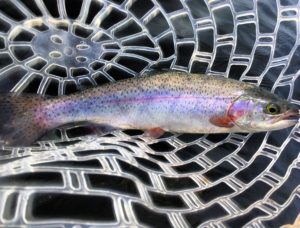It was a cold winter, and living on the west coast of Canada, our second and third winter’s were a bit chilly as well (Canadian’s know how mother nature likes to taunt us with spring weather only to bring back winter). The lakes took a while to become active again and with consistent visits to the mountains I’m now getting to see more action and have higher success. Now, with much of a welcome spring is here and the ice, snow and bone chilling weather is gone the fish are alive again.
With spring time very much present the trout are showing their rosy cheeks indicating spawning season is among us. They’re moving to their spawning grounds from their normal spots in the rivers, tributaries and lakes and getting ready to bring their next generations in.
Handling fish respectfully and consciously during a catch and release fishing trip is a responsibilty every angler should take on. How to care for the fish once you’ve hooked it and reeled it in can make all the difference in that individuals fait once it leaves your hands and nets.

While out fishing I love getting to enjoy nature, the peace and the chase for fish as well as getting to let them carry on to continue to flourish in their habitat to continue to grow and reproduce for future generations.
Like I mentioned, knowing how to handle fish properly to minimize handling time, impact and effect it important. So what are some things that you can do to help these beauties go with little harm?
-When getting your gear ready for your day on the water, make sure to pinch your barbs or use Barbless Fishing Hooks. This will allow you to be able to remove the hook faster, cleaner and easier when you land that fish in your net. When doing catch and release ultra light gear isn’t recommended as you typically fight the fish for a longer period of time exhausting the fish sometimes to their brink of survival.
-Don’t bring the fish up on shore. By bringing the fish onto shore it applies to all the “no-no’s”. The rubbing of the rocks removes slime, the fish is out of water, it can also injure their heads (which are not able to take a bump like ours can).
-“Keep em’ wet”. That goes for both the fish and your hands. Fish have a protective layer of slime covering their bodies and if you handle the fish with dry hands you are more likely to remove that slime leaving the fish more prone to infections. Nets that have a nylon mesh also have the same effect as dry hands as well so try a knotless or a Soft Rubber Mesh Trout Catch and Release Net for your next catch and release trip.
-Revive your fish properly. If you were taught to move the fish back and forth in the water, don’t. First make sure you are in clear water, if you’ve mixed up sediments move over a bit to less irritated water. Then face the fish into the current and allow it to breathe on it’s own. Be patient and when the fish is ready to swim away let it at it’s own pace. You’ll feel its strength and stability come back to it when it is ready to swim away.

I definitely understand most of us enjoy getting a snap of our catch to keep as a reminder of our time on the river. If you’re planning on getting a picture just remember the 5 second rule. Keep the fish in the water until you are ready for the picture and then only remove it for a few seconds while you take your shot and then return to the water if you want to take a couple more. Just remember to only do this a time or two to make sure the fish has as little impact as possible.
Hope you have a great time out enjoying your local waters! I’d love to see your pictures of your catch and releases. Share them on Instagram with the #reelgal.
Happy Fishing!
